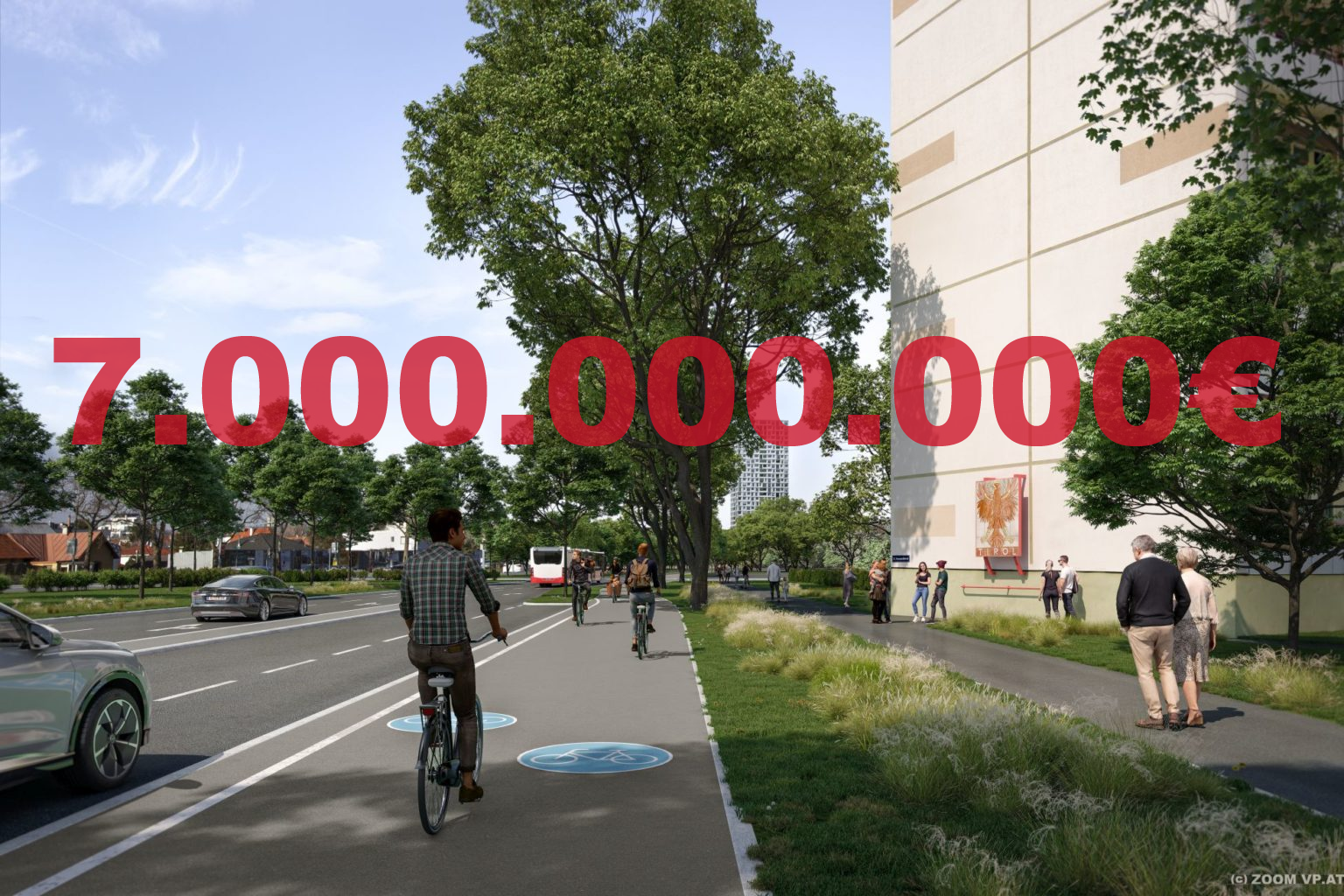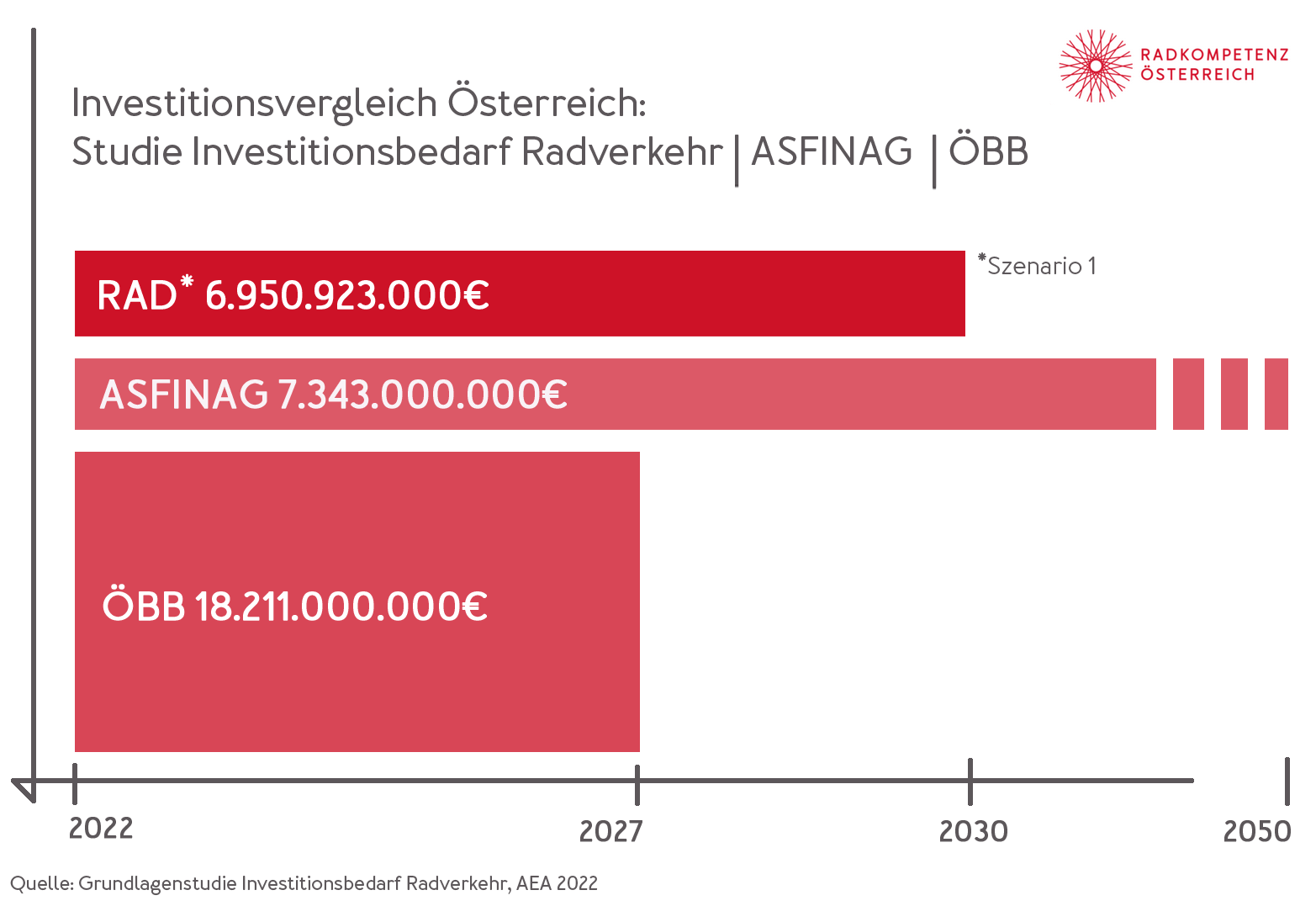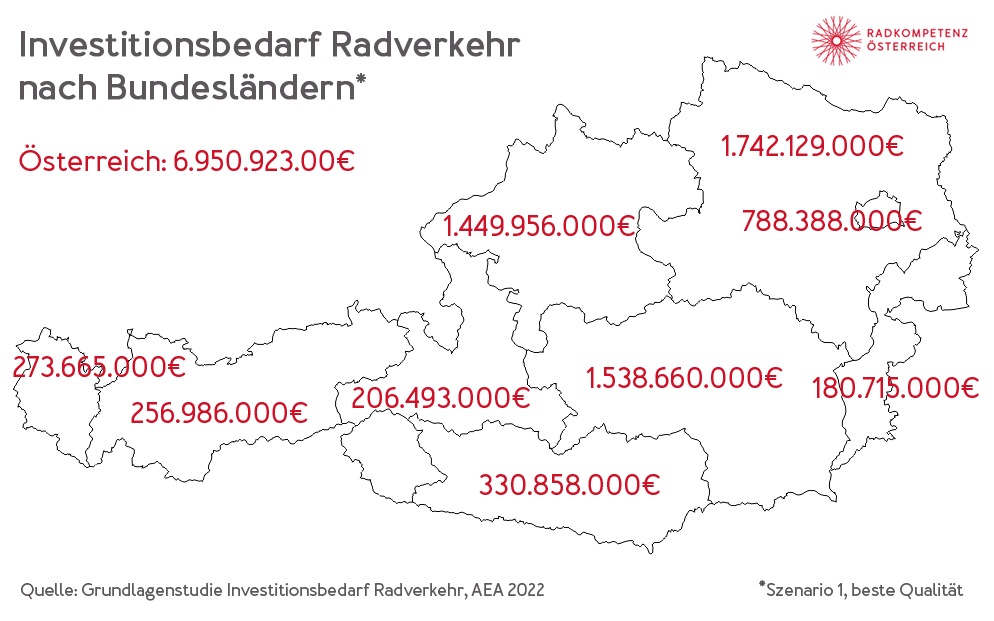Future-oriented Study: Austria’s cycle infrastructure needs 7 Billion Euros of investment.

A study published in April 2022 by Cycle Competence members Planoptimo and Verracon at the request of the Ministry for Climate Protection and all nine Austrian regions has shown exactly how much investment is necessary for Austria to increase cycling to reach the ‘Cycling Masterplan’ goal in 2030. Presuming the highest quality implementation, the figure stands at 7 billion Euros.This fascinating specialist study also presents many new insights and answers to questions such as: exactly how many kilometres of bike lane are missing? And how can this be accurately modelled?
The study is a cooperation between regional and national government in order to estimate the investment needed to successfully achieve the goals of the ‘Cycling Masterplan’ and to structure a detailed budget for the various subspecialties involved in its execution. The results of the study can now be used as a basis for further discussion of the next steps. The goal of these discussions should be to raise the level of cycle investment to match the respective budgets of the ÖBB and ASFINAG, thus putting cycling on par with road and rail infrastructure.
Goals of regional and national government require investment
Alongside the ‘Cycling Masterplan’, the goal of which is to double cycling participation to 13%, the Austrian government passed a climate and energy strategy in May 2018 called #mission2030. The strategy sets a course for Austria to meet the goals of the European Union for greenhouse gas reduction, renewable energy sources and energy efficiency by 2030. The strategy is particularly focused on traffic. As well as the national strategy, all nine regional governments have also committed themselves to the goals and have, in some cases, developed their own regional strategies. Back in 2018, Cycle Competence Austria already calculated how much more public finance would have to be invested per citizen per year in order to achieve a meaningful change in Austria’s modal split towards cycling, arriving at a figure of at least €30,-. The 3 billion Euro overall investment figure for 2020-2030 forecast in 2018 served as a starting point for the comprehensive studies which we have presented first as an overview, and now here in its detailed form.
In Summary: The 8 components of the investment package
The results of the study demonstrate the need to drastically increase cycle infrastructure investment to between 5.57 and 6.95 billion Euros depending on the exact breakdown of measures. The differences between scenarios 1, 2 and 3 stem from the different proportions of physically segregated bike lanes in each infrastructure packet, the most extensive of which would cost a total of 6.95 billion Euros.
1. Infrastructure for moving traffic: The biggest chunk of the budget is devoted to everyday traffic: between 4 and 5.4 billion Euros are necessary for the expansion of regional and local commuting networks. Additionally, 600 million is needed for the inclusion and development of cycle superhighways and 240 million to close gaps in existing leisure networks.
2. Infrastructure for Parking: In second place, 144 million Euros are needed for the construction of bicycle parking at stations, bus stops and tram stops as well as in other public spaces. In order to improve the experience of travelling with a bicycle on Austrian trains, the ÖBB has proposed 22 million Euros of improvements. This will include 52 new and converted Railjet wagons equipped with bike lifts to accommodate bicycles as well as providing 100 Cityjets with hybrid wagon solutions which will enable easier and more flexible person and bicycle transport.
3. Bicycle hire systems: The investment requirements in this sector are comprised of introductions of planned systems, expansion of existing hire schemes, and renewal of old bike fleets by 2030. Here, only publicly funded systems were taken into account, not those privately offered in the tourism sector. According to participating regions and cities, the costs involved in this are around 33 million Euros up to 2030, most of which is due to Vienna’s new Citybike scheme at 27.6 million Euros. With this money, Vienna is completely refreshing its Citybike system to comprise 200 stations and 3000 bikes, including service and repair costs, distribution and customer service.
4. Communication: For this sector, 1.5 Euros per citizen per year has been allocated, totalling 134 million Euros by 2030. This will be used for things such as events, campaigns, marketing and image-building.
5. Subsidies for Businesses and Individuals: The entire packet of subsidies for commercial and individual use has been estimated to cost 88 million Euros. This includes things like subsidies for bicycle parking in private housing areas as well as mobility management consultancy for businesses.
6. Research: Research costs in the field of cycle mobility have been estimated at 45 million Euros from now until 2030. This amount includes an increase in the amount of money available to fund new research projects to do with cycling. It is thought that in order to reach the goal of doubling cycling participation by 2030, research investment must be quadrupled. This increase in funding takes into account the wide spectrum of research projects carried out by the BMK, the Climate and Energy Trust (Klien) and regional governments across the country.
7. Education: In order to calculate the required amount of educational investment, various factors had to be taken into account such as the planned position of Chair of Cycling in Further Education and the nationwide cycling classes offered until the Austrian 8th grade. From now until 2030, costs of 96 million Euros must be allocated. Currently, around 1.3 million Euros is spent on cycle lessons in schools from the first to the fourth grade. The amount this would cost if expanded to all children in primary education would be 4.5 million Euros. The larger goal in terms of cycle lessons is to expand them into secondary education. This would increase necessary expenditure by a factor of two, to 9 million Euros per year.
8. Personnel: In order to achieve the above goals, the number of people working in the cycling industry and the diverse sectors associated with it must increase. This has been calculated using responses and feedback from the current employment levels relayed by regional governments. This shows requirements for 162 employees, each with yearly costs of 100,000 Euros associated with their jobs and thus a budgetary requirement of 162 million over ten years.
According to the authors of the study, discussions must now take place on local, regional and national levels between all the relevant actors to establish frameworks in which the necessary measures can be financed and implemented, the basis for which this study has now provided. The complete realisation of all of the above mentioned goals by 2030 seems fairly unrealistic for most of the regional governments. Even if all of the financial resources were available, a huge expansion of the workforce would be necessary on all levels to cover the extra work of planning and implementing the large variety of improvements. If this is not possible, the time frame for completing this evolution could end up being drastically increased: “following discussions with regional representatives, we have heard that a realistic projection for completion of the goals will be 2040” according to the study.
Three scenarios for the local expansion of cycle infrastructure
Due to the difficulty which planners often face when trying to implement physically separated bike paths in the centres of communities due to narrow street cross sections and a lack of space, three different scenarios have been drafted for investment in urban areas. Even cycle routes in mixed traffic, for example, still entail the extra costs of road markings and signage.
- Scenario 1: The total possible physically segregated bike routing is implemented to its fullest extent.
- Scenario 2: 50% of the possible physically segregated bike routing is implemented. Where it is more difficult, the remaining 50% is solved with alternative measures which provide cycle safety such as the introduction of bike priority streets, coloured road markings and other physical elements requiring minimal space. In order to effectively implement a bike priority street, measures are required which are over and above simple markings and signage, such as adapting road elements. These obviously entail extra costs.
- Scenario 3: The needs of the road are covered exclusively by the implementation of a bike priority street and other changes to the layout of the road.
The total investment requirements for moving bicycle traffic in Austria, taking into account the three different scenarios, has been estimated at 4.85 – 6.23 billion Euros and has also been calculated for the individual Austrian regions. The lowest development is required in Burgenland in scenario 3 at 103 million Euros. The highest development would be required in Lower Austria in scenario 1 at more than 1.6 billion Euros. As of 2021, the populations of Burgenland compared to Lower Austria are respectively 298,000 to 1,691,000.
Cycling Competence Members in this article:
More articles with this member:
Share this article:
Future-oriented Study: Austria’s cycle infrastructure needs 7 Billion Euros of investment.
Share this article:

A study published in April 2022 by Cycle Competence members Planoptimo and Verracon at the request of the Ministry for Climate Protection and all nine Austrian regions has shown exactly how much investment is necessary for Austria to increase cycling to reach the ‘Cycling Masterplan’ goal in 2030. Presuming the highest quality implementation, the figure stands at 7 billion Euros.This fascinating specialist study also presents many new insights and answers to questions such as: exactly how many kilometres of bike lane are missing? And how can this be accurately modelled?
The study is a cooperation between regional and national government in order to estimate the investment needed to successfully achieve the goals of the ‘Cycling Masterplan’ and to structure a detailed budget for the various subspecialties involved in its execution. The results of the study can now be used as a basis for further discussion of the next steps. The goal of these discussions should be to raise the level of cycle investment to match the respective budgets of the ÖBB and ASFINAG, thus putting cycling on par with road and rail infrastructure.
Goals of regional and national government require investment
Alongside the ‘Cycling Masterplan’, the goal of which is to double cycling participation to 13%, the Austrian government passed a climate and energy strategy in May 2018 called #mission2030. The strategy sets a course for Austria to meet the goals of the European Union for greenhouse gas reduction, renewable energy sources and energy efficiency by 2030. The strategy is particularly focused on traffic. As well as the national strategy, all nine regional governments have also committed themselves to the goals and have, in some cases, developed their own regional strategies. Back in 2018, Cycle Competence Austria already calculated how much more public finance would have to be invested per citizen per year in order to achieve a meaningful change in Austria’s modal split towards cycling, arriving at a figure of at least €30,-. The 3 billion Euro overall investment figure for 2020-2030 forecast in 2018 served as a starting point for the comprehensive studies which we have presented first as an overview, and now here in its detailed form.
In Summary: The 8 components of the investment package
The results of the study demonstrate the need to drastically increase cycle infrastructure investment to between 5.57 and 6.95 billion Euros depending on the exact breakdown of measures. The differences between scenarios 1, 2 and 3 stem from the different proportions of physically segregated bike lanes in each infrastructure packet, the most extensive of which would cost a total of 6.95 billion Euros.
1. Infrastructure for moving traffic: The biggest chunk of the budget is devoted to everyday traffic: between 4 and 5.4 billion Euros are necessary for the expansion of regional and local commuting networks. Additionally, 600 million is needed for the inclusion and development of cycle superhighways and 240 million to close gaps in existing leisure networks.
2. Infrastructure for Parking: In second place, 144 million Euros are needed for the construction of bicycle parking at stations, bus stops and tram stops as well as in other public spaces. In order to improve the experience of travelling with a bicycle on Austrian trains, the ÖBB has proposed 22 million Euros of improvements. This will include 52 new and converted Railjet wagons equipped with bike lifts to accommodate bicycles as well as providing 100 Cityjets with hybrid wagon solutions which will enable easier and more flexible person and bicycle transport.
3. Bicycle hire systems: The investment requirements in this sector are comprised of introductions of planned systems, expansion of existing hire schemes, and renewal of old bike fleets by 2030. Here, only publicly funded systems were taken into account, not those privately offered in the tourism sector. According to participating regions and cities, the costs involved in this are around 33 million Euros up to 2030, most of which is due to Vienna’s new Citybike scheme at 27.6 million Euros. With this money, Vienna is completely refreshing its Citybike system to comprise 200 stations and 3000 bikes, including service and repair costs, distribution and customer service.
4. Communication: For this sector, 1.5 Euros per citizen per year has been allocated, totalling 134 million Euros by 2030. This will be used for things such as events, campaigns, marketing and image-building.
5. Subsidies for Businesses and Individuals: The entire packet of subsidies for commercial and individual use has been estimated to cost 88 million Euros. This includes things like subsidies for bicycle parking in private housing areas as well as mobility management consultancy for businesses.
6. Research: Research costs in the field of cycle mobility have been estimated at 45 million Euros from now until 2030. This amount includes an increase in the amount of money available to fund new research projects to do with cycling. It is thought that in order to reach the goal of doubling cycling participation by 2030, research investment must be quadrupled. This increase in funding takes into account the wide spectrum of research projects carried out by the BMK, the Climate and Energy Trust (Klien) and regional governments across the country.
7. Education: In order to calculate the required amount of educational investment, various factors had to be taken into account such as the planned position of Chair of Cycling in Further Education and the nationwide cycling classes offered until the Austrian 8th grade. From now until 2030, costs of 96 million Euros must be allocated. Currently, around 1.3 million Euros is spent on cycle lessons in schools from the first to the fourth grade. The amount this would cost if expanded to all children in primary education would be 4.5 million Euros. The larger goal in terms of cycle lessons is to expand them into secondary education. This would increase necessary expenditure by a factor of two, to 9 million Euros per year.
8. Personnel: In order to achieve the above goals, the number of people working in the cycling industry and the diverse sectors associated with it must increase. This has been calculated using responses and feedback from the current employment levels relayed by regional governments. This shows requirements for 162 employees, each with yearly costs of 100,000 Euros associated with their jobs and thus a budgetary requirement of 162 million over ten years.
According to the authors of the study, discussions must now take place on local, regional and national levels between all the relevant actors to establish frameworks in which the necessary measures can be financed and implemented, the basis for which this study has now provided. The complete realisation of all of the above mentioned goals by 2030 seems fairly unrealistic for most of the regional governments. Even if all of the financial resources were available, a huge expansion of the workforce would be necessary on all levels to cover the extra work of planning and implementing the large variety of improvements. If this is not possible, the time frame for completing this evolution could end up being drastically increased: “following discussions with regional representatives, we have heard that a realistic projection for completion of the goals will be 2040” according to the study.
Three scenarios for the local expansion of cycle infrastructure
Due to the difficulty which planners often face when trying to implement physically separated bike paths in the centres of communities due to narrow street cross sections and a lack of space, three different scenarios have been drafted for investment in urban areas. Even cycle routes in mixed traffic, for example, still entail the extra costs of road markings and signage.
- Scenario 1: The total possible physically segregated bike routing is implemented to its fullest extent.
- Scenario 2: 50% of the possible physically segregated bike routing is implemented. Where it is more difficult, the remaining 50% is solved with alternative measures which provide cycle safety such as the introduction of bike priority streets, coloured road markings and other physical elements requiring minimal space. In order to effectively implement a bike priority street, measures are required which are over and above simple markings and signage, such as adapting road elements. These obviously entail extra costs.
- Scenario 3: The needs of the road are covered exclusively by the implementation of a bike priority street and other changes to the layout of the road.
The total investment requirements for moving bicycle traffic in Austria, taking into account the three different scenarios, has been estimated at 4.85 – 6.23 billion Euros and has also been calculated for the individual Austrian regions. The lowest development is required in Burgenland in scenario 3 at 103 million Euros. The highest development would be required in Lower Austria in scenario 1 at more than 1.6 billion Euros. As of 2021, the populations of Burgenland compared to Lower Austria are respectively 298,000 to 1,691,000.



